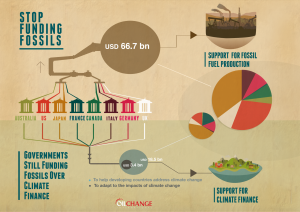Download the full infographic here.
A handful of wealthy countries are still funding fossil fuels instead of climate action. Collectively, Australia, Canada, France, Germany, Italy, Japan, the United Kingdom, and the United States are spending:
- 3.6 times more public money to prop up fossil fuel companies than they’re giving to developing countries to address climate change ($66.7 billion vs. $18.5 billion)
- 2.6 times more public money to prop up fossil fuel companies than all countries are spending to help developing countries address climate change ($66.7 billion to $25.5 billion)
- 15.5 times more public money to prop up fossil fuel companies than all countries are spending to help developing countries adapt to the impacts of climate change ($66.7 billion to $4.3 billion)

Financial Support for Fossil Fuels Greatly Outweighs Climate Finance
In the Paris Agreement, governments committed to a long term goal of limiting global warming to “well-below 2ºC” and striving to limit the temperature increase to 1.5?C above pre-industrial levels. According to a recent report from Oil Change International, the potential carbon emissions from the oil, gas, and coal in the world’s currently operating fields and mines would take us beyond 2°C of warming, while the reserves in currently operating oil and gas fields alone, even with no coal, would take the world beyond 1.5°C. In order to stay within climate limits, no new fossil fuel extraction or transportation infrastructure should be built.
This infographic clearly demonstrates that governments’ financial support for fossil fuel production not only continues at extremely high levels – but that it is also greatly outpacing support for climate action in developing countries. When pressed to provide more resources to help developing countries reduce their climate pollution and to build resilience against the impacts of climate change, wealthier countries often say that the “cupboards are bare;” there’s just not enough public money to go around. Yet these same governments are spending tens of billions of dollars in public money to expand fossil fuel production every year.
The analysis compares the amount of government support for fossil fuel production (including subsidies to oil, gas, and coal companies and public finance for fossil fuel infrastructure) from a select set of countries, to the amount those same countries have self-reported in public climate finance. Figures for both amounts are the annual average over the years 2013 and 2014.
The countries included in this analysis are those that are both:
- (a) G20 members, and so have pledged to end fossil fuel subsidies under the G20 in 2009; and
- (b) Annex II countries under the United Nations Framework Convention on Climate Change, giving them a clear obligation to contribute climate finance for developing countries.
Given that these countries are obligated to both eliminate their fossil fuel subsidies and also to provide climate finance, they were chosen to illustrate the fact that vast sums of public money are still being spent on fossil fuel production, taking us in the opposite direction of the 1.5ºC and 2ºC climate limits agreed in Paris.
Government support for fossil fuel production also runs contrary Article 2(c) of the Paris Agreement, which identifies one of the agreement’s objectives as, “Making finance flows consistent with a pathway towards low greenhouse gas emissions and climate-resilient development.”
Data Sources:
Data on subsidies and public finance for fossil fuel production comes from the Overseas Development Institute and Oil Change International report “Empty Promises: G20 subsidies to oil, gas and coal production.” Note that the subsidy figures are highly conservative. They do not include subsidies to fossil fuel consumers – only to fossil fuel producers; nor do the figures include investment in fossil fuel production by state-owned enterprise.
Data on climate finance is self-reported by governments, taken from the UNFCCC Second Biennial Reports, in the biennial reporting common tabular format (BR2 CTF). These submissions are public and available on the UNFCCC website. These self-reported figures may be overestimates, making this analysis more conservative. For example, Japan’s self-reported climate finance likely includes finance for coal-fired power plants, which they consider to be “high-efficiency” and thus a climate solution, a position which was strongly challenged by an analysis conducted by Ecofys earlier this year.
